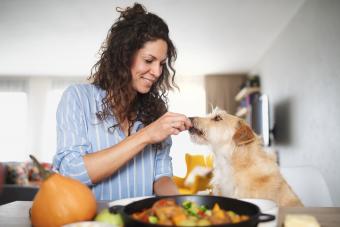
Giving your dogs fruit as an occasional treat is a healthy way to supplement their meals. Many fruits are safe for dogs to eat and have health benefits, in addition to your dog considering them delicious! Be careful what you offer, though. While some fruits are incredibly healthy, others can be toxic.
Fruits Safe for Your Dog
These fruits are good snacks and treats for your dog to consume:
- Apples: Rich in fiber, calcium and vitamin C and A
- Bananas: Include potassium, fiber, magnesium, vitamin B6, and vitamin C.
- Blueberries: Excellent source of vitamin C, phytochemicals, antioxidants, and fiber
- Cantaloupe: Full of fiber, antioxidants, potassium, vitamins A, B6, and C
- Cherries: Rich in vitamin A, vitamin C, antioxidants, and fiber
- Cranberries: High in antioxidants, manganese, and vitamin C
- Kiwi: Packed with vitamin C and potassium
- Mango: Good source of vitamins A, B6, C, and E, as well as fiber
- Oranges: Contain vitamin C and potassium
- Peaches: High in fiber, vitamin A, and vitamin C
- Pears: Full of vitamin C and fiber
- Pineapple: Rich source of vitamin B6 and C and important nutrients like potassium, magnesium, iron, calcium
- Raspberries: High in vitamins B-complex, C and K, and manganese and fiber
- Strawberries: Good source of fiber, folate, potassium, vitamin C and antioxidants
- Watermelon: Full of potassium and vitamins A, B6 and C
How Much Can They Eat?
Some veterinarians suggest using a rule of keeping fruit to no more than 10% of your dog's overall meals and treat options each day. Moderation is the key when it comes to giving your dog fruit. Too much of a good thing can turn into a bad thing. Only offer small servings of fruit - a few small, cut up pieces - as a food topper to supplement a meal, or as a treat. This will help prevent diarrhea and general stomach distress.
If you have a dog that is overweight or has diabetes, discuss feeding fruit with your veterinarian. Always observe your dog after feeding fruit to see if they develop vomiting, diarrhea, or constipation.

Preparing Your Dog's Fruit
There are tons of ways you can prep fruits for your dog. Apples are great cut into small pieces (just don't let them eat the core). Or you can put apple slices in a dehydrator to make a snack for your dogs, or puree them to make applesauce.
Chop bananas into small slices and give as a treat or mash some up and mix it with your dog's kibble. Offer a handful of blueberries on top of your dog's food or as a delightful treat. Just make sure slices or servings are small.
Other foods can be prepped for your dog to give them a cool treat. Freeze cantaloupe in small slices or chunks (but limit this fruit to avoid overconsumption of sugar). Cranberries are great fresh, dried, or cooked, again in moderation.
Some fruits, such as apples and pears, should have seeds removed before you feed them to your dog. With watermelon, remove the seeds and rind and provide a few small pieces. Basically, take anything off the fruit - such as tough or inedible skin, stems, and seeds - to make sure fruits are safe for your dog.
Fruits Dogs Should Avoid
While there are many fruits that your dog can safely enjoy, there are some you should definitely avoid giving to your pup. These can cause serious stomach problems and may be very toxic.
Dehydrating Fruit for Dog Treats
A great way to feed fruit to your dog is by making them into dehydrated dog treats. This helps preserve them, and compared to fruit-based treats you can buy at the store, it's much cheaper to do it yourself! Plus, there will be fewer chemicals and preservatives. Some fruits that do well in a dehydrator include apples, bananas, mangoes, and strawberries.
How to Tell if a Fruit is Upsetting Your Dog's Stomach
It isn't always easy to tell if your dog's system tolerates an otherwise safe fruit well. If your dog is trying a fruit for the first time, watch for the following signs of GI distress.
- Loss of appetite
- Lethargy
- Vomiting
- Loose stools or diarrhea
If your dog has consumed a "safe" fruit, but is experiencing any of these signs, do not feed that particular food again. Or, if you believe you offered too much, give them a smaller amount next time.

What to Do if Your Dog Eats Toxic Fruit
If you suspect your dog has consumed a toxic fruit or the pit of a fruit, follow these steps:
- As soon as you suspect your dog has ingested a toxic fruit, call your veterinarian or an emergency vet for guidance.
- If your veterinarian is not available, call the ASPCA Animal Poison Control Center. It's open 24 hours a day, 365 days a year, at 888-426-4435.
- Your veterinarian or poison control may recommend specific treatments or interventions based on how your dog is reacting and the type of fruit ingested. Follow these instructions carefully.
Always consult a veterinarian before attempting to induce vomiting in your dog. Inducing vomiting can do more harm than good in some cases.
Feeding Your Dog Fruit
As long as you keep the amounts small and make sure you're feeding a "safe" fruit, there's no reason you and your dog can't enjoy a delicious and healthy snack together. Whether you feed it raw, fermented, dehydrated or mashed, fruit can be an excellent addition to a dog's diet and provide powerful antioxidants and nutrients.







